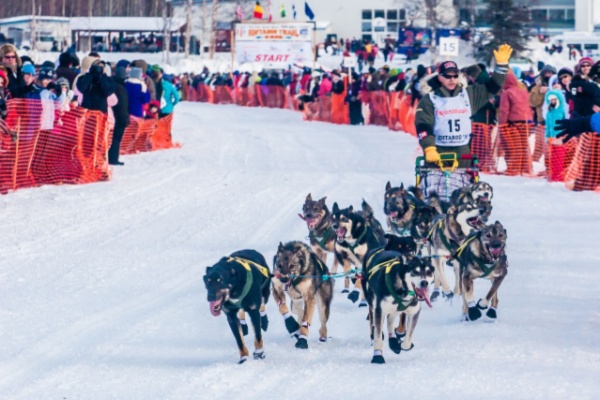Two dogs died over the weekend during Alaska’s annual Iditarod sled dog race, marking the first deaths during the race in five years and renewing calls to end the 1,000-mile (1,609-kilometer) competition that sees mushers and their canine teams traverse mountain ranges, a frozen river and sea ice — often during treacherous weather.
As AP News reports, Bog, a 2-year-old male on musher Issac Teaford’s team, collapsed Sunday morning about 200 feet (61 meters) short of the checkpoint in the village of Nulato, a former Russian trading post located 582 miles (937 km) into the race across the Alaska wilderness. He died despite a veterinarian performing CPR for about 20 minutes.
A second dog, George, a 4-year-old male on musher Hunter Keefe’s team, also collapsed and died despite attempts to revive him, a race statement said. George died on the trail about 35 miles (56 kilometers) outside of the village of Kaltag, which is 629 miles (1,012 km) into the race.
A necropsy did not determine a cause of death for Bog, and the Iditarod said further testing will be conducted. A necropsy on George will also be conducted.
Both Keefe and Teaford voluntarily quit the Iditarod Trail Sled Dog Race after their dogs’ deaths on Sunday. Had they not voluntarily pulled out, under the race rules, they risked being withdrawn by the race marshal. Both Keefe and Teaford are fairly inexperienced in running the Iditarod, one of the world’s longest sled dog races. Teaford is a rookie and Keefe was in his second race after finishing 11th last year.
The last dog to die during the annual race was Oshi, a 5-year-old female on musher Richie Beattie’s team, in 2019. At a post-race checkup, veterinarians found signs of pneumonia in the dog. She was flown to Anchorage for care but later died.
The dogs’ deaths on Sunday prompted People for the Ethical Treatment of Animals (PETA), long the Iditarod’s biggest critic, to call for race’s end. “The death count keeps climbing for dogs who are forced to run until their bodies break down, all so the human winner can get a trophy while the dogs get an icy grave,” PETA Senior Vice President Colleen O’Brien said in a statement. “PETA is calling for this despicable race to end.”
Although race officials have refused to provide an official count of dogs that have died since the first race was held in 1973, PETA states that more than 150 dogs have died attempting the Iditarod.
The organization conducted a protest outside the convention center where the mushers’ banquet was held before the ceremonial start of the race March 2 in Anchorage. PETA has also targeted race sponsors to end their support of the race in recent years. Companies that have quit sponsorship include Alaska Airlines, ExxonMobil, Wells Fargo and Chrysler, through an Anchorage dealership.
The organization earlier called for musher Dallas Seavey to be removed from this year’s race after his dog Faloo was injured in a deadly encounter with a moose that got entangled with his sled team shortly after the race started. Seavey was given a two-hour time penalty for not properly gutting the moose after he shot it. PETA claims he delayed care for the dog.
Despite the time penalty, Seavey had a healthy lead Monday morning. GPS tracking on the Iditarod Insider webpage showed him with a 16-mile (26-kilometer) lead over the second-place musher, Jessie Holmes. Seavey, who was about 155 miles (249 kilometers) from the finish, is trying to win his sixth championship. He’s currently tied with Rick Swenson for the most wins at five each.
In the months leading up to this year’s race, five other dogs died and eight were injured during training runs after snowmobiles hit the dog teams. “Mushers’ prioritization of victory over dogs’ wellbeing is everything that’s wrong with the Iditarod,” PETA Executive Vice President Tracy Reiman said in a statement.
The race, which takes about 10 days, started with 38 mushers at the ceremonial start in Anchorage. Since then, five have left the grueling race. The route takes mushers over two mountain ranges, along the frozen Yukon River and the Bering Sea ice before ending in the Gold Rush town of Nome. The winner is expected to be announced this week.
—
Photo Credit: Troutnut / Shutterstock.com
